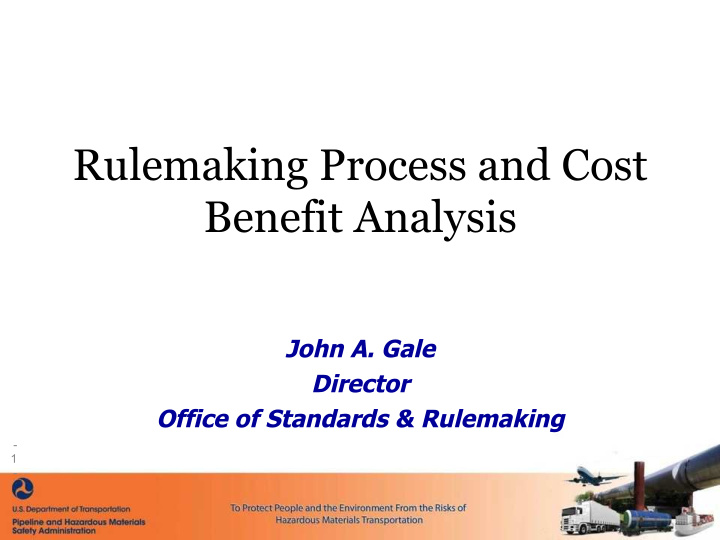



Rulemaking Process and Cost Benefit Analysis John A. Gale Director Office of Standards & Rulemaking - 1 -
Goals • Regulatory Process – Improve your knowledge of the regulatory process – Improve your knowledge of how you can be involved in the process • Cost Benefit Analysis – Better understanding of how “Cost Benefit Analysis” affects rulemaking development – in particular rulemakings affecting pipeline safety - 2 -
Steps 1-5 • Step 1 – Initiating event – THE PROBLEM” • Steps 2 & 3 – Development of the Notice of Proposed Rulemaking – Development of cost benefit analysis (Regulatory Impact Analysis” – Small Business Impact – Information Collection • Step 4 – OMB Review – Significant rule • Step 5 – Publication of NPRM in the Federal Register - – Public comment period 4 -
www.regulations.gov • Please comment!!! – Positive or negative comments. – Additional data – https://www.federalregister.gov/agencies - 5 -
Steps 6-9 (Plus one more) • Extra Step – Pipeline Advisory Committees – GPAC/LPAC • Steps 6-7 – summarize comments, develop final rule, revise proposed regulatory changes based on comments and data • Step 8 OMB Review • Step 9 Publish in the Federal Register - 6 -
Rule Process • Non-Significant rules • PHMSA - Federal Register • Significant rules • PHMSA - OST – OMB – Federal Register • OMB Determines what rules are Significant – Most PHMSA Pipeline Safety Rulemakings are deemed Significant - 7 -
Rule Process • Significant vs Non-Significant Rulemakings (EO 12866) • Have an annual effect on the economy of $100 million or more… • Create a serious inconsistency or with another agency; • Materially alter the budgetary impact of entitlements, grants, user fees, or loan programs or the rights and obligations of recipients thereof; or • Raise novel legal or policy issues arising out of legal mandates, the President’s priorities, or the principles set forth in this Executive order. - 8 -
Relational Reference Significant Rulemakings Statute(s) OMB Secretary of DOT Administrator of PHMSA Office of Pipeline Safety
Rule Process • Where can I find information on the Status of rulemakings? – PHMSA – www.phmsa.dot.gov – DOT • DOT Significant Rulemakings (Monthly reports) – www.dot.gov /regulations/report-on-significant- rulemakings – OMB • www.reginfo.gov - 1 0 -
DOT Significant Rulemaking report Milestone Originally New Actual Scheduled Projected Date Date Date To OST 11/18/2011 05/22/2012 06/13/2012 Returned to Mode 06/28/2012 Resubmitted to OST 07/16/2012 09/17/2012 Returned to Mode/2 10/04/2013 Resubmitted to OST 12/05/2013 Returned to C-1 02/21/2014 Returned to S-1 03/07/2014 To OMB 12/16/2011 04/15/2014 05/01/2014 OMB Clearance 03/19/2012 09/22/2015 09/17/2015 Publication Date 03/30/2012 10/02/2015 10/13/2015 End of Comment Period 05/30/2012 12/02/2015 01/08/2016 - 1 1 -
Cost Benefit Analysis • EO 12866, EO 13563 and OMB guidance A4 – Provides Federal agencies guidance and direction on the development of regulatory analysis – …agencies should propose or adopt a regulation only upon a reasoned determination that is its benefits justify its costs… – Select those regulatory approaches that maximize net benefits - 1 2 -
Cost Benefit Analysis • Cost benefit analysis – 49 USC 60102(b)(5) – Federal Pipeline Safety Statute • “… the Secretary shall propose or issue a standard under this chapter only upon a reasoned determination that the benefits of the intended standard justify its costs.” • Pipeline Advisory Committees • Mandate vs Discretion • if appropriate; reasonable; practicable; minimize - 1 costs 3 -
Cost Benefit Analysis § Averages over last 20 years for Gas Transmission incidents: § Fatalities – 2 § Injuries – 9 § Property damages - $88.6 million § Excluding excavation damage/Outside or natural force damage incidents: § Fatalities - 1 § Injuries - 6 § Property damages - $52.3 million - 1 4 -
Cost and Benefits • Number of Gas Transmission miles that would be affected to Hydro-test a mile of pipeline: • 45,000 miles • Estimated cost to implement NPMS amendments: • PHMSA – $85 million over three years – INGAA - $820m covering 180,000 miles of GT – API - $10.8m-$21m per operator - 1 5 -
THOUGHTS • Rulemaking development is a process • Improve our “benefit formula” • Bring additional economic expertise into the organization • Public involvement/engagement/ education 1 6
QUESTIONS - 1 7 -
Current Rulemakings in Process • Hazardous Liquid NPRM • Gas Transmission NPRM • Excess Flow Valve NPRM • Plastic Pipe NPRM • Operator Qualification and Cost Recovery NPRM • Rupture Detection and Automatic shutoff Valve NPRM • Standards Update • Excavation Damage Final Rule • Miscellaneous Final Rule - 1 8 -
Recommend
More recommend